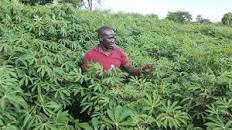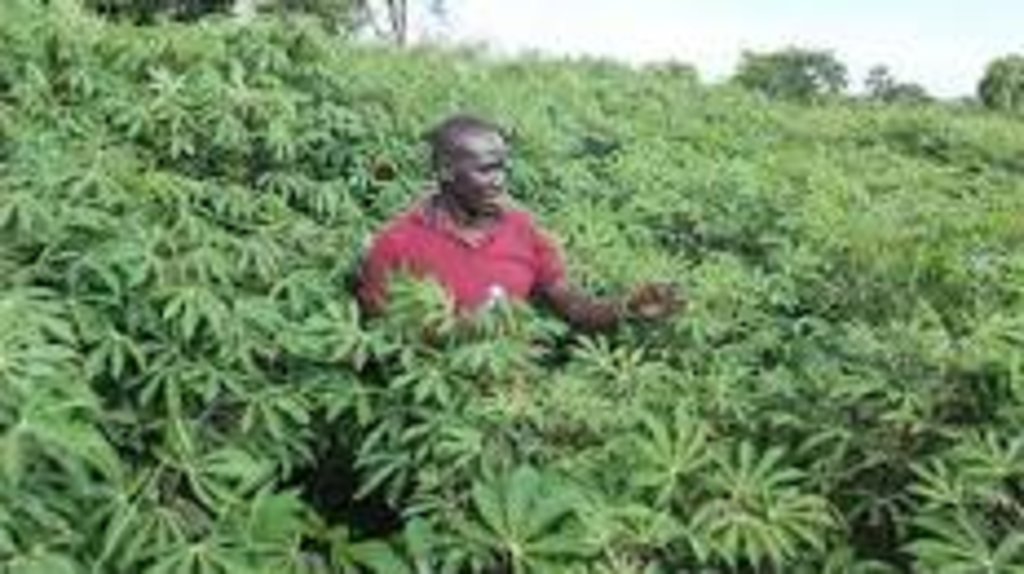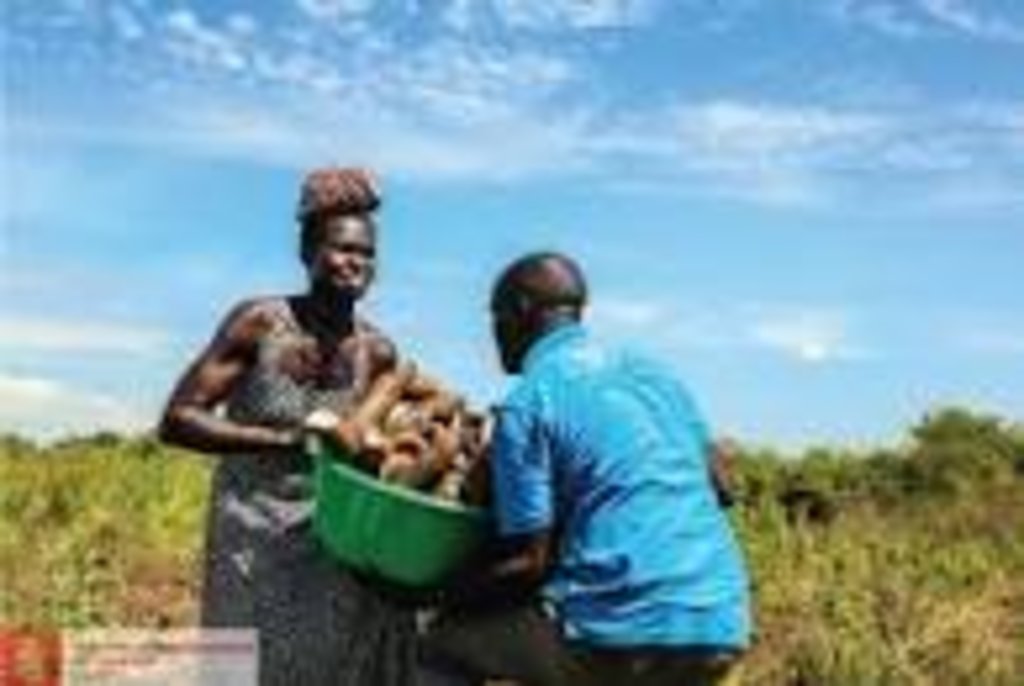CROP ROTATION OF CASSAVA AND SOY BEAN [乌干达]
- 创建:
- 更新:
- 编制者: betty adoch
- 编辑者: JOY TUKAHIRWA, Kamugisha Rick Nelson
- 审查者: Udo Höggel
leno cam i poto
technologies_2699 - 乌干达
查看章节
全部展开 全部收起1. 一般信息
1.2 参与该技术评估和文件编制的资源人员和机构的联系方式
关键资源人
土地使用者:
Olal Levi
Agago District Local Government
Kazikazi parish, Arum village.
乌干达
有助于对技术进行记录/评估的项目名称(如相关)
Scaling-up SLM practices by smallholder farmers (IFAD)有助于对技术进行记录/评估的机构名称(如相关)
CDE Centre for Development and Environment (CDE Centre for Development and Environment) - 瑞士1.3 关于使用通过WOCAT记录的数据的条件
(现场)数据是什么时候汇编的?:
10/05/2017
编制者和关键资源人员接受有关使用通过WOCAT记录数据的条件。:
是
1.4 所述技术的可持续性声明
这里所描述的技术在土地退化方面是否存在问题,导致无法被认为是一种可持续的土地管理技术?:
否
注释:
Crop rotation enhance soil fertility since different plant consume different plant nutrients.
2. SLM技术的说明
2.1 技术简介
技术定义:
The improved variety of cassava known as Nafe14 is grown on a gentle slope. Animal traction was used to plough 43 acres of land. The land was initially used for growing soya beans. The cassava garden has some trenches dug across so to control flooding and soil erosion. By this a high moisture content is retained in the soil. This cassava species is drought resistant.
2.2 技术的详细说明
说明:
Crop rotation is the growing of different crops in the same piece of land year after year. This land user grows Cassava (Manihota esculenta) and Soy beans (Glycine max). in the field. The improved cassava variety (Nafe 14) was planted in 2015 on 43 acres during rainy season. The planting hole was dug 6 inches (square) in length and 6 to 10 inches depth, spaced at one meter distance.
The cassava stem is cut at 6 inch length and the planting may be done immediately as the holes are dug. If the area has termites then it should rain into the planting hole and later should stay for two days after which planting should be done. This is because the rain should seal the termites traces in order to protect the cassava stem from being destroyed by termites. Cassava growing protects the soil from erosion, is a source of income and protects land from wrangles.
Weeding is constantly done to control weed and to promote high yields.
2.3 技术照片
2.4 技术视频
日期:
10/05/2017
位置:
Agago District
摄影师的名字:
Betty Adoch
2.5 已应用该技术的、本评估所涵盖的国家/地区/地点
国家:
乌干达
区域/州/省:
Northern Uganda
有关地点的进一步说明:
Agago Town council
2.6 实施日期
注明实施年份:
2015
2.7 技术介绍
详细说明该技术是如何引入的:
- 通过土地使用者的创新
注释(项目类型等):
The land user obtained the cassava stems from Agago District Local Government which, again was being supplied by Operation Wealth Creation.
3. SLM技术的分类
3.1 该技术的主要目的
- 改良生产
- 减少、预防、恢复土地退化
- 保持/提高生物多样性
- 降低灾害风险
- 适应气候变化/极端天气及其影响
- 创造有益的经济影响
- 创造有益的社会影响
3.2 应用该技术的当前土地利用类型

农田
- 一年一作
主要农作物(经济作物及粮食作物):
Cassava
3.3 有关土地利用的更多信息
该技术所应用土地的供水:
- 雨养
注释:
There is need for irrigation during dry season.
每年的生长季节数:
- 1
3.4 该技术所属的SLM组
- 轮作制度(轮作、休耕、轮垦)
3.5 技术传播
具体说明该技术的分布:
- 均匀地分布在一个区域
如果该技术均匀地分布在一个区域上,请注明覆盖的大致区域。:
- < 0.1 平方千米(10 公顷)
注释:
cassava growing is sustainable in terms of soil conservation.
3.6 包含该技术的可持续土地管理措施

农艺措施
- A1:植被和土壤覆盖层
- A2:有机质/土壤肥力
- A5:种子管理,改良品种
3.7 该技术强调的主要土地退化类型

土壤水蚀
- Wt:表土流失/地表侵蚀
- Wo:场外劣化效应

土壤风蚀
- Et:表土流失
- Eo:场外劣化效应

生物性退化
- Bc:植被覆盖的减少
- Bh:栖息地丧失
- Bs:质量和物种组成/多样性的下降
- Bl:土壤寿命损失
注释:
The methods protects the soil from both human-induced- and natural causes of degradation.
3.8 防止、减少或恢复土地退化
具体数量名该技术与土地退化有关的目标:
- 防止土地退化
- 减少土地退化
注释:
The mentods conserves soil moisture and nutrients.
4. 技术规范、实施活动、投入和成本
4.1 该技术的技术图纸
4.2 技术规范/技术图纸说明
The improved cassava variety (Nafe 14) was planted in 2015 on 43 acres during rainy season. The planting hole was dug 6 inches (square) in length and 6 to 10 inches depth, spaced at one meter distance.
4.3 有关投入和成本计算的一般信息
具体说明成本和投入是如何计算的:
- 每个技术区域
注明尺寸和面积单位:
43 acres
其它/国家货币(具体说明):
UGX
注明美元与当地货币的汇率(如相关):1美元=:
3500.0
注明雇用劳工的每日平均工资成本:
3000shs
4.4 技术建立活动
| 活动 | 措施类型 | 时间 | |
|---|---|---|---|
| 1. | Acquiring cassava stems from Operation Wealth Creation | 农业学的 | dry season |
| 2. | Clearing the land by tractor | 农业学的 | onset of rainy season |
| 3. | Planting using hired labour | 农业学的 | rainy season |
4.5 技术建立所需要的费用和投入
| 对投入进行具体说明 | 单位 | 数量 | 单位成本 | 每项投入的总成本 | 土地使用者承担的成本% | |
|---|---|---|---|---|---|---|
| 劳动力 | Hired labour | acres | 43.0 | 48000.0 | 2064000.0 | 100.0 |
| 设备 | Tractor for ploughing | hours | 48.0 | 20000.0 | 960000.0 | 100.0 |
| 设备 | Ox-plough | hours | 48.0 | 20000.0 | 960000.0 | 100.0 |
| 设备 | Axes | piece | 10.0 | 7000.0 | 70000.0 | 100.0 |
| 设备 | Hoes | piece | 20.0 | 12000.0 | 240000.0 | 100.0 |
| 植物材料 | Cassava cuttings | acres | 43.0 | 20000.0 | 860000.0 | 100.0 |
| 技术建立所需总成本 | 5154000.0 | |||||
注释:
Cassava cuttings were provided free of charge by the local government.
4.6 维护/经常性活动
| 活动 | 措施类型 | 时间/频率 | |
|---|---|---|---|
| 1. | Weeding | 农业学的 | wet season |
| 2. | Fire line | 农业学的 | dry season |
注释:
Fire out breaks during dry season may destroy cassava gardens
4.7 维护/经常性活动所需要的费用和投入(每年)
| 对投入进行具体说明 | 单位 | 数量 | 单位成本 | 每项投入的总成本 | 土地使用者承担的成本% | |
|---|---|---|---|---|---|---|
| 劳动力 | Weeding | acre | 43.0 | 2500.0 | 107500.0 | 100.0 |
| 设备 | Hoes | piece | 60.0 | 12000.0 | 720000.0 | 100.0 |
| 设备 | Pangas | piece | 60.0 | 7000.0 | 420000.0 | 100.0 |
| 技术维护所需总成本 | 1247500.0 | |||||
注释:
The land user has adequate capital to invest in cassava growing.
5. 自然和人文环境
5.1 气候
年降雨量
- < 250毫米
- 251-500毫米
- 501-750毫米
- 751-1,000毫米
- 1,001-1,500毫米
- 1,501-2,000毫米
- 2,001-3,000毫米
- 3,001-4,000毫米
- > 4,000毫米
指定年平均降雨量(若已知),单位为mm:
950.00
有关降雨的规范/注释:
Rainfall is moderate and unreliable during wet season in the months of April, May, June, July, August, September and October. Whereas November, December, January, Feburary and March it is dry season and there is little or no rainfall at all.
注明所考虑的参考气象站名称:
Kitgum Weather Station
农业气候带
- 半湿润
Savanna climate where rainfall is moderate and unreliable during wet season.
5.2 地形
平均坡度:
- 水平(0-2%)
- 缓降(3-5%)
- 平缓(6-10%)
- 滚坡(11-15%)
- 崎岖(16-30%)
- 陡峭(31-60%)
- 非常陡峭(>60%)
地形:
- 高原/平原
- 山脊
- 山坡
- 山地斜坡
- 麓坡
- 谷底
垂直分布带:
- 0-100 m a.s.l.
- 101-500 m a.s.l.
- 501-1,000 m a.s.l.
- 1,001-1,500 m a.s.l.
- 1,501-2,000 m a.s.l.
- 2,001-2,500 m a.s.l.
- 2,501-3,000 m a.s.l.
- 3,001-4,000 m a.s.l.
- > 4,000 m a.s.l.
说明该技术是否专门应用于:
- 不相关
5.3 土壤
平均土层深度:
- 非常浅(0-20厘米)
- 浅(21-50厘米)
- 中等深度(51-80厘米)
- 深(81-120厘米)
- 非常深(> 120厘米)
土壤质地(表土):
- 中粒(壤土、粉土)
土壤质地(地表以下> 20厘米):
- 中粒(壤土、粉土)
表土有机质:
- 中(1-3%)
5.4 水资源可用性和质量
地下水位表:
5-50米
地表水的可用性:
好
水质(未处理):
不良饮用水(需要处理)
水的盐度有问题吗?:
是
具体说明:
salty and rusty borehole
该区域正在发生洪水吗?:
否
5.5 生物多样性
物种多样性:
- 高
栖息地多样性:
- 高
关于生物多样性的注释和进一步规范:
Wild rats, birds all coexist in the garden.
5.6 应用该技术的土地使用者的特征
定栖或游牧:
- 定栖的
生产系统的市场定位:
- 生计(自给)
非农收入:
- 收入的10-50%
相对财富水平:
- 平均水平
个人或集体:
- 个人/家庭
机械化水平:
- 畜力牵引
- 机械化/电动
性别:
- 女人
- 男人
土地使用者的年龄:
- 中年人
- 老年人
说明土地使用者的其他有关特征:
The land user owns 80 cattle, goats, chickens and turkeys.
5.7 应用该技术的土地使用者拥有或租用的平均土地面积
- < 0.5 公顷
- 0.5-1 公顷
- 1-2 公顷
- 2-5公顷
- 5-15公顷
- 15-50公顷
- 50-100公顷
- 100-500公顷
- 500-1,000公顷
- 1,000-10,000公顷
- > 10,000公顷
这被认为是小规模、中规模还是大规模的(参照当地实际情况)?:
- 小规模的
注释:
The land is fertile and supports cassava growing.
5.8 土地所有权、土地使用权和水使用权
土地所有权:
- 个人,未命名
土地使用权:
- 个人
用水权:
- 社区(有组织)
注释:
The land owner should acquire land title to reduce land related conflicts.
5.9 进入服务和基础设施的通道
健康:
- 贫瘠
- 适度的
- 好
教育:
- 贫瘠
- 适度的
- 好
技术援助:
- 贫瘠
- 适度的
- 好
就业(例如非农):
- 贫瘠
- 适度的
- 好
市场:
- 贫瘠
- 适度的
- 好
能源:
- 贫瘠
- 适度的
- 好
道路和交通:
- 贫瘠
- 适度的
- 好
饮用水和卫生设施:
- 贫瘠
- 适度的
- 好
金融服务:
- 贫瘠
- 适度的
- 好
6. 影响和结论性说明
6.1 该技术的现场影响
社会经济效应
生产
作物生产
SLM之前的数量:
low
SLM之后的数量:
high
注释/具体说明:
Improved variety planted.
作物质量
SLM之前的数量:
Low
SLM之后的数量:
High
注释/具体说明:
High yielding cassava Nafe14 variety is used.
收入和成本
农业投入费用
SLM之前的数量:
low
SLM之后的数量:
high
注释/具体说明:
Cassava plantation requires less labor force after planting.
农业收入
SLM之前的数量:
low
SLM之后的数量:
high
注释/具体说明:
Has greatly increased income generation.
收入来源的多样性
SLM之前的数量:
low
SLM之后的数量:
high
注释/具体说明:
The farmer has other sources of income from cassava growing.
经济差异
SLM之前的数量:
high
SLM之后的数量:
low
注释/具体说明:
The land user has assured source of income.
社会文化影响
食品安全/自给自足
SLM之前的数量:
low
SLM之后的数量:
high
注释/具体说明:
Cassava provides constant food supply to the land user.
SLM/土地退化知识
SLM之前的数量:
low
SLM之后的数量:
high
注释/具体说明:
The farmer has learned about the importance crop rotation.
生态影响
土壤
土壤水分
SLM之前的数量:
low
SLM之后的数量:
high
注释/具体说明:
The cassava plants reduces the rate of evaporation.
土壤覆盖层
SLM之前的数量:
low
SLM之后的数量:
high
注释/具体说明:
Cassava plant protects the soil from erosion and provides habitat to a variety of different plant species.
生物多样性:植被、动物
植被覆盖
SLM之前的数量:
low
SLM之后的数量:
high
注释/具体说明:
Variety of plant species exist in the garden.
植物多样性
SLM之前的数量:
low
SLM之后的数量:
high
注释/具体说明:
Cassava and other plant species exist.
6.3 技术对渐变气候以及与气候相关的极端情况/灾害的暴露和敏感性(土地使用者认为的极端情况/灾害)
渐变气候
渐变气候
| 季节 | 气候变化/极端天气的类型 | 该技术是如何应对的? | |
|---|---|---|---|
| 年温度 | 增加 | 适度 | |
| 季节性温度 | 旱季 | 增加 | 适度 |
| 年降雨量 | 减少 | 适度 | |
| 季雨量 | 湿季/雨季 | 减少 | 适度 |
气候有关的极端情况(灾害)
气象灾害
| 该技术是如何应对的? | |
|---|---|
| 局地暴雨 | 适度 |
| 局地雷暴 | 适度 |
| 局地雹灾 | 适度 |
| 局地风暴 | 适度 |
气候灾害
| 该技术是如何应对的? | |
|---|---|
| 干旱 | 适度 |
生物灾害
| 该技术是如何应对的? | |
|---|---|
| 流行病 | 适度 |
| 昆虫/蠕虫侵扰 | 适度 |
注释:
Cassava growing is a sustainable land management practice.
6.4 成本效益分析
技术收益与技术建立成本相比如何(从土地使用者的角度看)?
短期回报:
稍微积极
长期回报:
积极
技术收益与技术维护成本/经常性成本相比如何(从土地使用者的角度看)?
短期回报:
稍微积极
长期回报:
积极
注释:
Cassava has high demand due to hunger facing the communities.
6.5 技术采用
- 1-10%
如若可行,进行量化(住户数量和/或覆盖面积):
15 households
在所有采用这项技术的人当中,有多少人是自发地采用该技术,即未获得任何物质奖励/付款?:
- 90-100%
注释:
Cassava growing is a traditional way of earning income and provide food to the family.
6.6 适应
最近是否对该技术进行了修改以适应不断变化的条件?:
是
若是,说明它适应了哪些变化的条件:
- 不断变化的市场
具体说明技术的适应性(设计、材料/品种等):
Improved high yielding cassava variety planted to earn income.
6.7 该技术的优点/长处/机会
| 土地使用者眼中的长处/优势/机会 |
|---|
| Very good at providing income after selling cassava and soya bean |
| Very easy to replicate |
| 编制者或其他关键资源人员认为的长处/优势/机会 |
|---|
| Source of employment for both small, medium and large scale farmers. |
6.8 技术的弱点/缺点/风险及其克服方法
| 土地使用者认为的弱点/缺点/风险 | 如何克服它们? |
|---|---|
| Invites thieves during hunger period | Tight security in the garden |
| The variety take long to mature | |
| Cassava is prone to disease | Spraying with herbicide |
| 编制者或其他关键资源人员认为的弱点/缺点/风险 | 如何克服它们? |
|---|---|
| Expensive to establish and maintain the garden | Employing low costs labour |
7. 参考和链接
7.1 信息的方法/来源
- 实地考察、实地调查
01
- 与土地使用者的访谈
01
7.2 参考可用出版物
标题、作者、年份、ISBN:
Intercropping and crop rotations in cassava cultivation: a production systems approachThomas W. Kuyper, Wageningen University, The Netherlands; and Samuel Adjei-Nsiah,
7.3 链接到网络上可用的相关信息
标题/说明:
Field stability of cassava, maize, soya bean and cowpea intercrops DAPAAH, H K; ASAFU-AGYEI, J N; ENNIN, S A; YAMOAH, C. The Journal of Agricultural Science; Cambridge Vol. 140, Iss. 1, (Feb 2003): 73-82.
URL:
https://www.proquest.com/docview/203707559
链接和模块
全部展开 全部收起链接
无链接
模块
无模块






